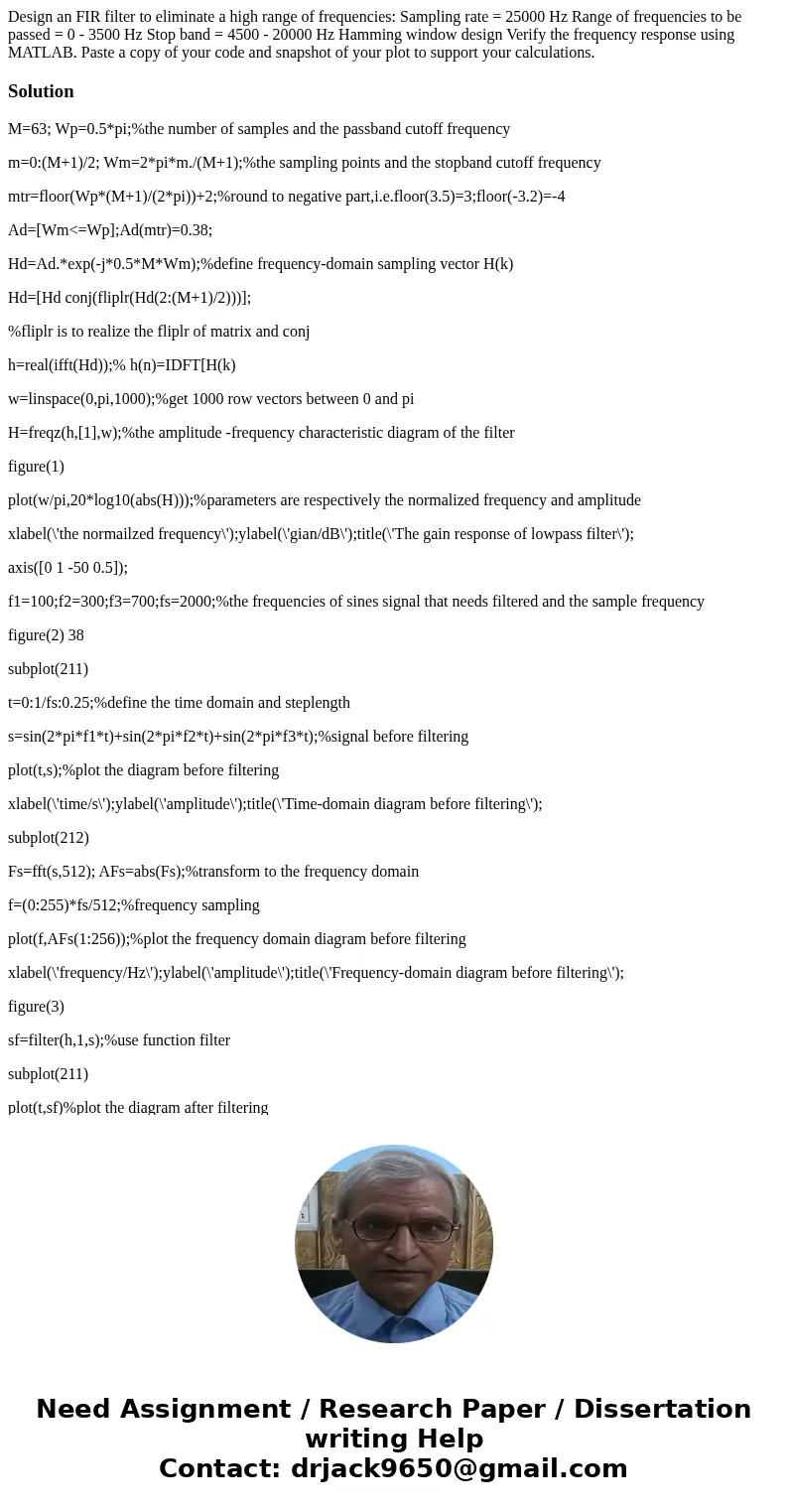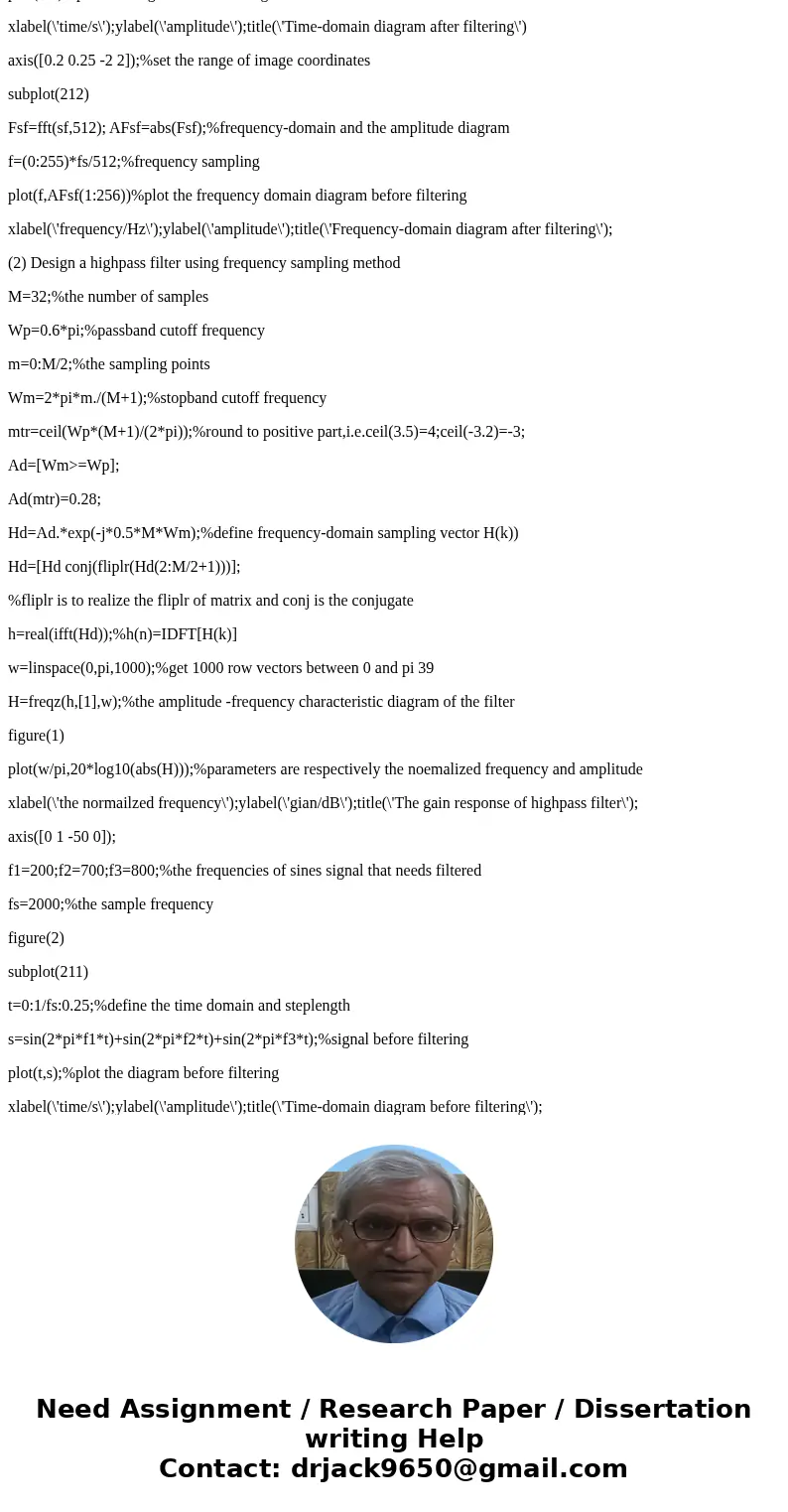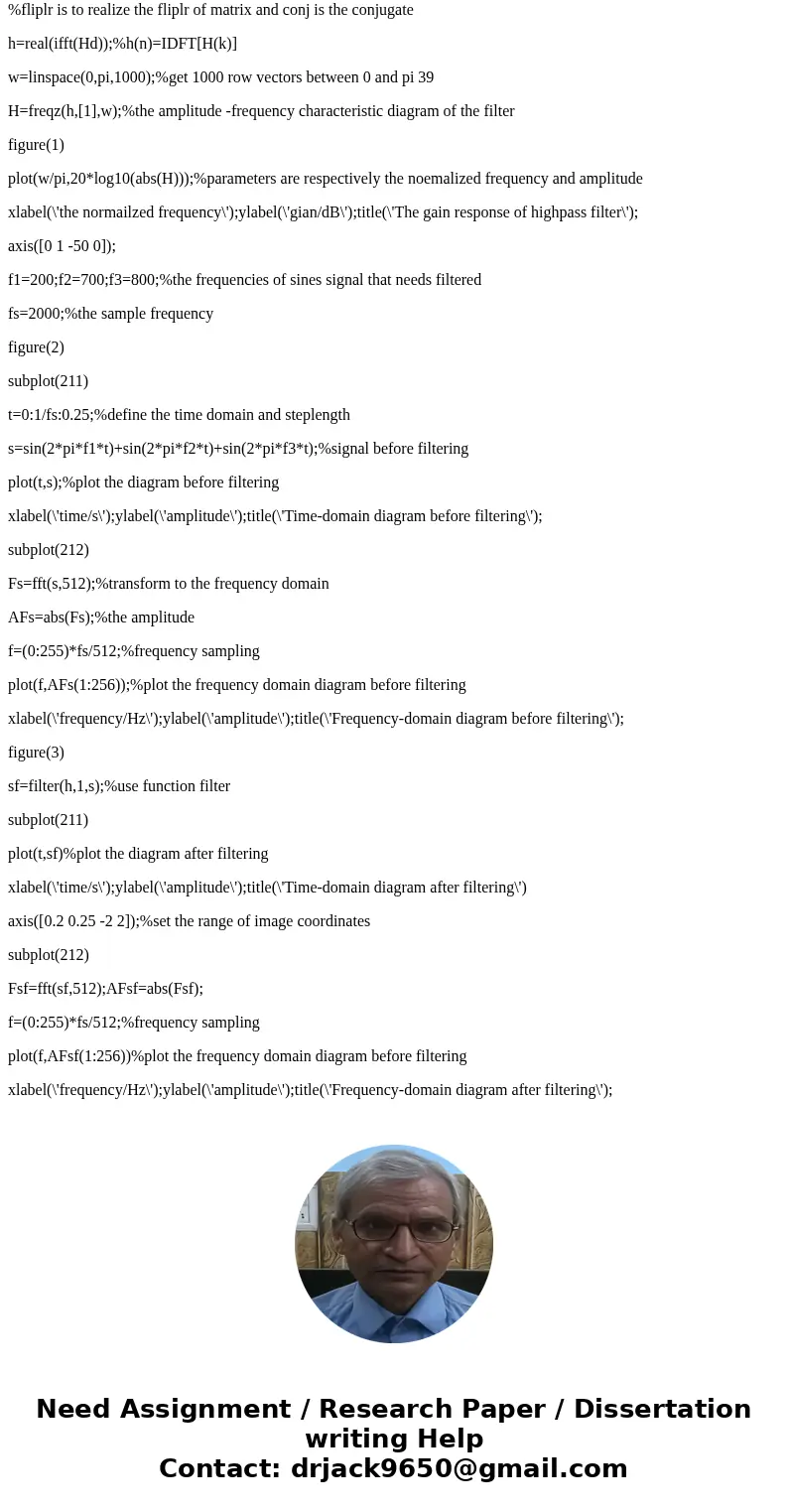Design an FIR filter to eliminate a high range of frequencie
Solution
M=63; Wp=0.5*pi;%the number of samples and the passband cutoff frequency
m=0:(M+1)/2; Wm=2*pi*m./(M+1);%the sampling points and the stopband cutoff frequency
mtr=floor(Wp*(M+1)/(2*pi))+2;%round to negative part,i.e.floor(3.5)=3;floor(-3.2)=-4
Ad=[Wm<=Wp];Ad(mtr)=0.38;
Hd=Ad.*exp(-j*0.5*M*Wm);%define frequency-domain sampling vector H(k)
Hd=[Hd conj(fliplr(Hd(2:(M+1)/2)))];
%fliplr is to realize the fliplr of matrix and conj
h=real(ifft(Hd));% h(n)=IDFT[H(k)
w=linspace(0,pi,1000);%get 1000 row vectors between 0 and pi
H=freqz(h,[1],w);%the amplitude -frequency characteristic diagram of the filter
figure(1)
plot(w/pi,20*log10(abs(H)));%parameters are respectively the normalized frequency and amplitude
xlabel(\'the normailzed frequency\');ylabel(\'gian/dB\');title(\'The gain response of lowpass filter\');
axis([0 1 -50 0.5]);
f1=100;f2=300;f3=700;fs=2000;%the frequencies of sines signal that needs filtered and the sample frequency
figure(2) 38
subplot(211)
t=0:1/fs:0.25;%define the time domain and steplength
s=sin(2*pi*f1*t)+sin(2*pi*f2*t)+sin(2*pi*f3*t);%signal before filtering
plot(t,s);%plot the diagram before filtering
xlabel(\'time/s\');ylabel(\'amplitude\');title(\'Time-domain diagram before filtering\');
subplot(212)
Fs=fft(s,512); AFs=abs(Fs);%transform to the frequency domain
f=(0:255)*fs/512;%frequency sampling
plot(f,AFs(1:256));%plot the frequency domain diagram before filtering
xlabel(\'frequency/Hz\');ylabel(\'amplitude\');title(\'Frequency-domain diagram before filtering\');
figure(3)
sf=filter(h,1,s);%use function filter
subplot(211)
plot(t,sf)%plot the diagram after filtering
xlabel(\'time/s\');ylabel(\'amplitude\');title(\'Time-domain diagram after filtering\')
axis([0.2 0.25 -2 2]);%set the range of image coordinates
subplot(212)
Fsf=fft(sf,512); AFsf=abs(Fsf);%frequency-domain and the amplitude diagram
f=(0:255)*fs/512;%frequency sampling
plot(f,AFsf(1:256))%plot the frequency domain diagram before filtering
xlabel(\'frequency/Hz\');ylabel(\'amplitude\');title(\'Frequency-domain diagram after filtering\');
(2) Design a highpass filter using frequency sampling method
M=32;%the number of samples
Wp=0.6*pi;%passband cutoff frequency
m=0:M/2;%the sampling points
Wm=2*pi*m./(M+1);%stopband cutoff frequency
mtr=ceil(Wp*(M+1)/(2*pi));%round to positive part,i.e.ceil(3.5)=4;ceil(-3.2)=-3;
Ad=[Wm>=Wp];
Ad(mtr)=0.28;
Hd=Ad.*exp(-j*0.5*M*Wm);%define frequency-domain sampling vector H(k))
Hd=[Hd conj(fliplr(Hd(2:M/2+1)))];
%fliplr is to realize the fliplr of matrix and conj is the conjugate
h=real(ifft(Hd));%h(n)=IDFT[H(k)]
w=linspace(0,pi,1000);%get 1000 row vectors between 0 and pi 39
H=freqz(h,[1],w);%the amplitude -frequency characteristic diagram of the filter
figure(1)
plot(w/pi,20*log10(abs(H)));%parameters are respectively the noemalized frequency and amplitude
xlabel(\'the normailzed frequency\');ylabel(\'gian/dB\');title(\'The gain response of highpass filter\');
axis([0 1 -50 0]);
f1=200;f2=700;f3=800;%the frequencies of sines signal that needs filtered
fs=2000;%the sample frequency
figure(2)
subplot(211)
t=0:1/fs:0.25;%define the time domain and steplength
s=sin(2*pi*f1*t)+sin(2*pi*f2*t)+sin(2*pi*f3*t);%signal before filtering
plot(t,s);%plot the diagram before filtering
xlabel(\'time/s\');ylabel(\'amplitude\');title(\'Time-domain diagram before filtering\');
subplot(212)
Fs=fft(s,512);%transform to the frequency domain
AFs=abs(Fs);%the amplitude
f=(0:255)*fs/512;%frequency sampling
plot(f,AFs(1:256));%plot the frequency domain diagram before filtering
xlabel(\'frequency/Hz\');ylabel(\'amplitude\');title(\'Frequency-domain diagram before filtering\');
figure(3)
sf=filter(h,1,s);%use function filter
subplot(211)
plot(t,sf)%plot the diagram after filtering
xlabel(\'time/s\');ylabel(\'amplitude\');title(\'Time-domain diagram after filtering\')
axis([0.2 0.25 -2 2]);%set the range of image coordinates
subplot(212)
Fsf=fft(sf,512);AFsf=abs(Fsf);
f=(0:255)*fs/512;%frequency sampling
plot(f,AFsf(1:256))%plot the frequency domain diagram before filtering
xlabel(\'frequency/Hz\');ylabel(\'amplitude\');title(\'Frequency-domain diagram after filtering\');



 Homework Sourse
Homework Sourse